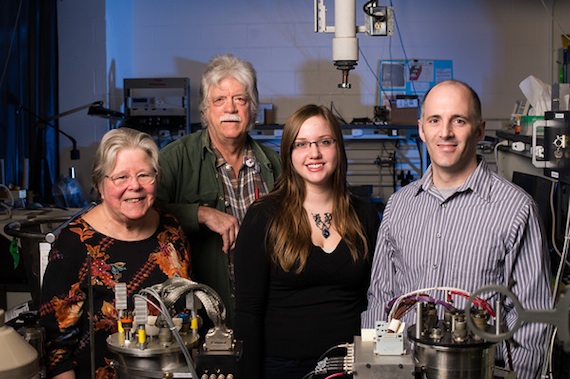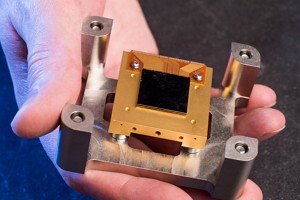New Sensor Could Help Detect Earth-bound Asteroids

''Rochester astronomers Judith L. Pipher, Bill Forrest, grad student Meghan Dorn and Craig McMurtry in front of a dewar containing an infrared detector array ready to be tested. Photo by J. Adam Fenster / University of Rochester''
A sensor designed to be the eyes of a future asteroid-tracking mission has passed a critical test. The Near Earth Object Camera (NEOCam) sensor is a new infrared-light detector to improve the performance and efficiency of the next generation of space-based asteroid-hunting telescopes. It is the result of a long-term collaboration between the University of Rochester and the Jet Propulsion Laboratory (JPL), together with Teledyne Imaging Sensors.
A paper on the NEOCam sensor test will be published in an upcoming issue of the Journal of Optical Engineering.
"The NEOCam sensor will increase our ability to detect hazardous asteroids near the Earth and improve our understanding of threatening objects," said William J. Forrest, professor of astronomy at the University of Rochester. The NASA-funded NEOCam space mission will also search for the most favorable destinations for future exploration by humans or robotic missions.
Asteroids do not emit visible light, they reflect it. When searching for near-Earth objects with optical telescopes (using visible light) the data collected can be deceiving because – depending on how reflective the object is – a small, light-colored space rock can look the same as a big, dark one.
Asteroids do, however, always emit infrared radiation. "We can learn more about asteroids when we look at them with infrared light," explained Amy Mainzer, an author on the paper and principal investigator for NASA's NEOWISE and NEOCam missions at the JPL in Pasadena, Calif. "When you observe a space rock with infrared, you are seeing its thermal emissions, which can better define the asteroid's size as well as tell you something about composition."
Asteroids emit most of their radiation at infrared wavelengths near about 10 microns (0.0004 inches), which humans perceive as heat. There is also relatively less radiation from stars and galaxies at these wavelengths, which simplifies detection of faint moving objects.
The sensor can be thought of as a megapixel camera chip that can collect infrared light at these wavelengths. "This sensor works at higher temperatures than any other similar ones we have at the moment," said Judith Pipher, emeritus professor in physics and astronomy at Rochester. "This means they can be passively cooled; making the instrument less heavy and less expensive to put into space."

Infrared detector array ready for testing at the Rochester lab. Photo by J. Adam Fenster/ University of Rochester.
The NEOCam sensor is made of mercury, cadmium, and tellurium. Pipher and her colleague Forrest started working on sensors from this combination of materials nearly 20 years ago, when they saw the potential they offered for higher operating temperatures.
Craig McMurtry, the paper's first author, is also a member of the Rochester team. "We were delighted to see in this generation of detectors a factor of 1000 improvement in sensitivity compared with previous generations, while simultaneously raising the operating temperature to one readily attainable in space," he said.
Another sensor, for infrared radiation of a different wavelength, developed by the Rochester team is currently aboard the Spitzer mission. It continues to operate, even after the cooling system ran out, therefore lengthening the lifetime of the mission beyond what had been planned.
Once launched, the space-based telescope would be positioned at a location about four times the distance between Earth and the moon. From this lofty perch, NEOCam could observe the comings and goings of NEOs every day without the impediments to efficient observing like cloud cover and even daylight. The location in space NEOCam would inhabit is important for another reason, as well - it allows the monitoring of areas of the sky generally inaccessible to ground-based surveys, while allowing scientists easy access to the data from the spacecraft.
Other authors on the paper include graduate student at Rochester Meghan Dorn; former student at Rochester and now at Roberts Wesleyan College Candice Bacon Fazar; the Teledyne team of Donald Lee, James Beletic, Chi-Yi Chen, Richard Demers, Dennis Edwall and Aristo Yulius; and Fengchuan Liu from JPL.
The Rochester group acknowledges support by NASA APRA grant NNX12AF39G. The JPL group received funding from the NASA Discovery program to fund the development and acquisition of long wave background arrays from Teledyne. Teledyne Imaging Sensors, Camarillo, Calif., produced the sensors. JPL manages the NEOCam sensor program for NASA's Science Mission Directorate.
More information about asteroids and near-Earth objects is at: http://www.jpl.nasa.gov/asteroidwatch.
